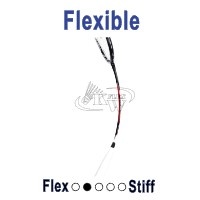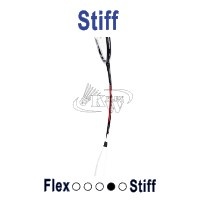Badminton racket Flexibility advice
Flexibility is the most discussed specification of a racket. It largely determines the sensation of a badminton racket. But why should you buy a flexible or stiff badminton racket? Read all about it in this badminton blog!
What kind of flexible badminton racket is best for me?
Buying a badminton racket is easy, but choosing one is always difficult. Or, you need to know exactly which specifications suit your playing style exactly. And even then, you don't always know how a racket will react to the court. To help you with the choice and to explain why certain factors influence the choice of a racket, we have written a series of blogs. Or are currently being written. Here you will find a complete explanation from our KW FLEX badminton specialist about flexibility!
How important are the following factors of a racket:
| Grip and grip size | 25% |
| Stringing | 20% |
| Balance point: head heavy ○○ ● ○○ Head light | 15% |
| Weight: i.c.w. Balance point | 15% |
| Flexibility: stiff ○○ ● ○○ Flexible | 15% |
| Frame technology and material | 10% |
| - 'snapback' made of steel | |
| - 'snapback' made of steel | |
| - Thickness of blade | |
| - Thickness of shaft | |
| - Aerodynamics | |
| - Maximum stringing force | |
| Total | 100% |

Flexible badminton rackets
Do you have enough strength and technique, and do you want more control? Then it is best to choose medium flexible / stiff badminton rackets. (The stiffer the racket, the faster it will punish mistakes and the more power you have to get from your technique and arm, but the advantage is more accuracy and control).
If you do not have that much power, it is better to look at more flexible badminton rackets. This will support you in developing speed in your strokes.
The flexibility of a badminton racket is divided into 5 categories, each of which has its own advantages and disadvantages.
- Extra stiff (Stiff ● ○○○○ Flexible)
- Stiff (Stiff ○ ● ○○○ Flexible)
- Medium flexible (Stiff ○○ ● ○○ Flexible)
- Flexible (Stiff ○○○ ● ○ Flexible)
- Extra flexible (Stiff ○○○○ ● Flexible)
What are the advantages of a flexible badminton racket?
Flexibility is the most discussed specification of a racket. It largely determines the sensation of a badminton racket. But why should you buy a flexible badminton racket?
(Flexible badminton racket)
Better for smash defense:
A flexible shaft is better for badminton players who have to defend a lot, because there is a longer bending moment of the shaft. The flexible shaft returns more slowly, creating more time. So, while receiving a smash, you have more time to let the shuttle change direction. This is very useful for hitting the shuttle cross court during a smash defense. You can surprise your opponent, make a point or take over the attack!
Arm-friendly and comfort
The second big advantage is the flexible shaft feels soft and comfortable during a hit. Much less force is required for the shaft to bend further. In that case, for a recreational / beginner, it feels much more comfortable / softer when the shuttle is hit. An additional advantage is that much less force is therefore required to hit the shuttle far in the back of the field!
"More power" or energy-saving
In marketing terms, the magic word "power" is often used. We prefer to call this "energy-saving". Do you know why? Below, we explain how this works.
The reasoning of the term "extra power" is because the shaft of the badminton racket bends more easily during a shot. So with less impact, the shaft gives more power.
We prefer to use the term "energy-saving", because the shuttle does not immediately fly further if the shaft is more flexible. The shuttle flies the same distance, but it requires less power from the player.
What are the disadvantages of a flexible badminton racket?
A famous saying is: Every advantage has its disadvantage. This also applies to the flexible shaft of a badminton racket, but at the same time these 'disadvantages' are the advantage of a stiff shaft! So the question is also: What are the advantages of a stiff badminton racket?
(stiff badminton racket)
Less control & power for advanced players
Did you know that a badminton player can hit harder than the shaft can keep up? This may sound strange, but for such an advanced player these racket feels like a fly swatter: slow, numb and little smash power. Sometimes a racket can also vibrate if the shaft is "too flexible". This does not suit an advanced badminton player with a lot of technique and power.
For an advanced player who likes to hit hard and precisely, a stiff shaft is very important. It gives a lot more feedback and speed on hard hits such as a smash, tight clears and drives. Even with short fast strokes on the net, it gives a fast response.
Perfect for a quick game to give the opponent less time.
Downside stiff badminton racket
A too stiff shaft will reduce power and may cause injuries. A badminton shaft should always bend resiliently during a hit. It therefore requires a fit arm and more technique. In many cases, it is not suitable for beginners and recreational users.
However, beginners and recreational users often still use too stiff shafts. They are often very old badminton rackets or cheap rackets that mainly look at the price and color. So be careful with this if you do not know what is good for your game and physical.
Flexibility "measure":
We think it is important to "measure" flexibility. The specifications stated by manufacturers are not always correct. Especially with cheaper rackets in the 30 - 80 euro price range, this is not considered as closely. In our badminton store and webshop you will only find rackets that have all been measured.
Besides the fact that the factory information is not always correct, it also happens that the flexibility is not indicated on the racket.
How do you measure the flexibility of a badminton racket?
Measuring flexibility is often based on feeling and experience. When players get their hands on a new racket, the first thing they do is hold the racket with 2 hands and bend it briefly. They then feel the resistance of the shaft and compare it with their own racket.
Experience and consistency are important in this method. We also apply this method, but then we compare each new racket from an assortment of several hundred models. From this range we select the most flexible, medium flexible and most stiff racket.
This way, we can compare every new badminton racket that is delivered. We think this is very important to check, because the data from the manufacturers is not always accurate. It could be a production deviation (then the shipment will be returned) or the specifications are not entirely correct.
Different standards are also sometimes used between the badminton brands. For good racket advice on the shaft, the specialist must know their entire range well and have measured it by their self. In that respect, you are 100% sure at the right place at KW FLEX.
Someone who wants a comparable stiffness can then take his / her own badminton racket to the store and compare it with the rackets in the store.
Even someone without experience can feel the difference between very flexible and stiff with a bend test.
Did you know that we at KW FLEX measure everything in our store in terms of badminton rackets and sportswear ourselves?
What flexibility does my badminton racket have?
In most cases this is written on the shaft and can therefore be seen as an indication. You can assume that the information on a racket of 150+ euros is correct. Are you unsure or do you want additional information? Ask for advice from an experienced badminton specialist.
Technical aspects of a shaft
A lot of technology is involved in the development of a shaft. There are various aspects such as:
- Thicknesses between 6.2 - 7.2 mm shaft
- Varied thicknesses in one shaft
- Length of the shaft
- Material of shaft, different types of graphite and possible additives
- Applied technique to assemble the shaft.
All these aspects can influence the bend ability, bending point and resilience. You would think it would make sense that a thick 7.2 mm shaft is stiffer and an ultra-thin 6.2 mm shaft is more flexible. Yet this is not the case. An expensive racket from around 130 euros, which includes more expensive material and more technology, can make a thin shaft stiffer than a cheap 7.2 mm shaft. So don't be guided by the price alone.
It is usually true that:
- A thicker shaft is stiffer, or a thin shaft is more flexible
- A shorter shaft is stiffer, in other words, a longer shaft is more flexible.
Check out your new badminton racket!
What flexibility do I need?
Of course, you are now wondering which type of flexibility suits you best. It is difficult to say this exactly, but we can make a general assumption.
- Are you a beginner or a recreational player without a lot of experience? Then take a flexible racket to prevent an injury. If you have a limited budget, take a medium flexible shaft.
- Are you an advanced badminton player with a fit arm, good hitting technique, and do you easily hit the shuttle from the back line? (and we don't mean about the sidelines, but back line haha) Then take a stiff shaft for more control and smash power!
- Then of course there remains a very large group of all-round players who can best focus on the medium flexible shaft.
We always advise doing not suddenly choose the complete opposite. If you have been using a very flexible racket for years, then you shouldn't switch to a stiff racket. There is a great risk that it does not feel good or that your arm / shoulder will be injured.
Flexible shaft:
- Youth, beginners and recreational users who have trouble getting the shuttle in the back.
- Defensive mode
- Advanced players who have been used to a flexible racket for a long time.
Medium flexible shaft:
- Youth
- Beginners who have a strong arm by profession (e.g. carpenter and electrician).
- Recreationalists
- Advanced players of all game types: defensive, all-round and offensive
Stiff shaft:
- For advanced players with a fit arm
- For attacking players and hard hitters
- For ambitious players who are used to a medium flexible shaft and are looking for more control and smashing power.




